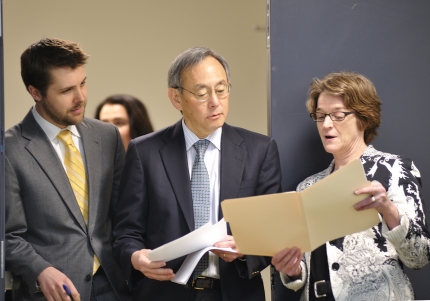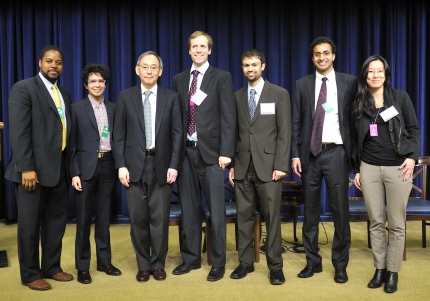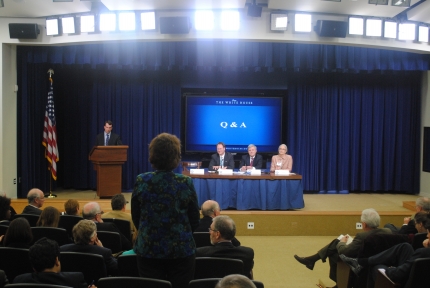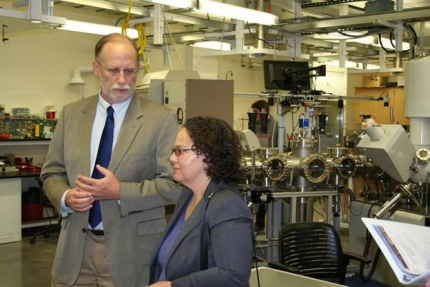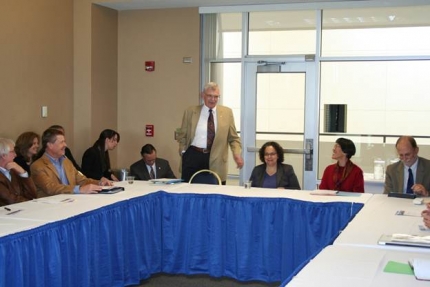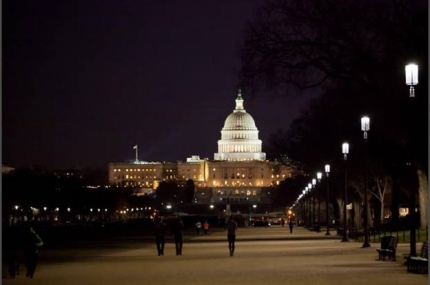Council on Environmental Quality Blog
Students Present Ideas for Better Buildings
Posted by on March 14, 2012 at 2:25 PM EDTPresident Obama has called for an all-of-the-above energy strategy, and one way we can prepare for the future is to engage students in creating energy solutions for the future. Recently, students from across the country came to the White House to present their ideas for energy efficient buildings. University teams—led by their respective energy club—tackled cases that focus on a number of the most common, most stubborn barriers to energy efficiency in both the private sector and in state and local settings. The students came from a variety of academic programs, including engineering, real estate, business/management, and policy.
The cases use real scenarios, information, and data provided by Better Buildings Challenge Partners and others in the commercial buildings industry. Students presented on two city policy scenarios and two private real estate scenarios, answering questions such as, "What is the best mechanism to significantly move the energy efficiency market?" Their creative and innovative solutions addressed policy, finance, business and real estate challenges.
This forum provides the next generation of engineers, entrepreneurs and policymakers with skills and experience to start careers in clean energy and generates creative solutions to real-world problems to be used as models by businesses and other organizations across the marketplace.
The event supported the Better Buildings Challenge, a national energy efficiency leadership initiative and a core element of President Obama's plan to make commercial buildings 20 percent more energy efficient by 2020. In addition to supporting significant energy reduction, the Better Buildings Challenge is focused on finding solutions to persistent barriers to energy efficiency that have limited the energy efficiency market.
Energy Secretary Steven Chu announced the winners of the competition and congratulated them for their efforts to tackle some of the most common and stubborn barriers to improving energy efficiency.
Participating Universities:
Babson College
Carnegie Mellon University
Columbia University
Dartmouth College
Duke University
The George Washington University
Georgetown University
Georgia Institute of Technology
Harvard University
Massachusetts Institute of Technology
Texas A&M University
Tufts University
University of California, Berkeley
University of California, Irvine
University of Colorado, Denver
University of Michigan, Ann Arbor
University of Southern California
Vanderbilt University
Yale UniversityRead more on the President's Better Buildings Initiative.
Maria Vargas is Director of the Better Buildings Challenge at the U.S. Department of Energy
Learn more about Energy and EnvironmentReducing Greenhouse Gas Pollution: Protecting Communities and Strengthening the Economy
Posted by on March 9, 2012 at 7:45 PM EDTIn January 2010, President Obama announced that the Federal Government would reduce the greenhouse gas (GHG) emissions from its operations by 28 percent by 2020. In his announcement the President remarked, “As the largest energy consumer in the United States, we have a responsibility to American citizens to reduce our energy use and become more efficient.”
This goal wasn’t just about improving the operations of government, but about living up to the Federal Government’s responsibility to all Americans to improve our economy and environment. In meeting this pollution reduction target, the Government will help American taxpayers avoid up to $11 billion in energy costs.
In line with this effort, the Council on Environment Quality (CEQ) is releasing revised GHG emissions accounting guidance for Federal agencies. The draft proposes revisions to guidance released in October 2010, which established Government-wide requirements for measuring and reporting GHG emissions associated with Federal agency operations. As agencies learn from their experience implementing the initial guidance, we are applying this knowledge in our continual quest to make Federal emissions reporting as accurate as possible.
As part of our Open Government initiative at CEQ, we are giving the public an opportunity to review this guidance and provide us with feedback. CEQ will review all public comments submitted in the next 30 days before finalizing the updated guidance.
We look forward to hearing from all of you as we continue to work toward the President’s goal to lower costs, reduce pollution, and transition to a cleaner, all-of-the-above energy strategy.
You can read the revised GHG plan and share your ideas here.
Nancy Sutley is Chair of the White House Council on Environmental Quality
Learn more about Energy and EnvironmentGreat Lakes Summit: Advancing Partnerships for Great Lakes Restoration
Posted by on February 29, 2012 at 6:00 PM EDTToday, CEQ hosted a White House Community Leaders Briefing on the Great Lakes Region with environmental, academic, business and civic leaders from throughout the Midwest. The briefing was an important opportunity for dialogue between Great Lakes leaders and senior Administration officials like Counselor to the President Pete Rouse, Secretary of Commerce John Bryson, Deputy Secretary of the Interior David Hayes, and USDA Deputy Under Secretary for Natural Resources and Environment Ann Mills, on the importance of community leadership in Great Lake restoration.
The Great Lakes are home to some of America's finest beaches, world-class fisheries, and some of the world's most popular tourist destinations. They are also one of the planet's greatest natural resources, providing drinking water for more than 30 million people and supporting one of the world's largest regional economies.
The Administration has made it a priority to work with state, city, environmental, academic and business leaders toward lasting solutions for the Great Lakes. We have made the most significant investment in history in Great Lakes restoration – more than $1 billion since the President took office – and launched the Great Lakes Restoration Initiative to dedicate sustained attention to restoring this vital ecosystem. Led by U.S. EPA, the initiative has already removed more than 1 million cubic yards of contaminated sediment and protected or restored more than 20,000 acres of essential habitat.
But there is much more work to do, and now is not the time to scale back our Nation's commitment to the Great Lakes. Most recently, the President's FY 2013 budget included $300 million to continue critical interagency Great Lakes ecosystem restoration work. These GLRI funds, combined with agencies' significant base Great Lakes funds, will help advance our collective work to return this ecosystem to health.
We are committed to continuing progress in the Great Lakes. Today's gathering at the White House was another important step in advancing the partnership between the Administration and the dynamic community of leaders that has fostered success for the Great Lakes Restoration Initiative and its goal of a healthy environment and thriving economy for all Americans.
Rohan Patel is Associate Director for Public Engagement at the White House Council on Environmental Quality
Learn more about Energy and EnvironmentBuilt to Last: Energy and the Environment in the Southwest
Posted by on February 14, 2012 at 2:40 PM EDTCISSEM is one of 46 Energy Frontiers Research Centers created under the American Recovery and Reinvestment Act of 2009. These centers are focused on transformative innovations in renewable energy production that will reduce our dependence on foreign oil and protect our environment. Appropriate to Arizona’s photon-rich landscape, UA’s center is at the cutting edge of the effort to create solar cells that are economically competitive with fossil fuels. Such cells must be both relatively inexpensive to manufacture and efficient at converting sunlight into electricity.
After visiting CISSEM’s laboratories, Chair Sutley was briefed on UA’s own sustainability efforts by Senior Associate Vice President for Business Affairs Bob Smith. In the Southwest, water management is a critical priority, and UA is conserving through efforts including waterless urinals, reclaimed water irrigation, water harvesting, xeriscaping, and irrigation scheduling. The University is also actively reducing energy consumption by installing photovoltaic and solar thermal panels on a number of campus buildings, lighting retrofits, combined heat and power plants, HVAC scheduling, high-efficiency boilers, smart thermostats, and more.
Chair Sutley wrapped up her visit to the University of Arizona at a sustainability roundtable with UA scientists, administrators, and students, moderated by UA Provost Jacquelyn Mok. In her opening remarks, the Chair noted several of the challenges facing federal policymakers: How do we best take advantage of the information technology revolution? How do we think about federal assets in the face of a changing planet so that we can provide actionable information to local and regional managers? And, how do we change from a stovepipe mindset to bring a systems approach to managing natural resources and energy systems? Steered by Executive Dean Joaquin Ruiz, a focus on water echoed throughout the discussion, since water is a critical variable in all natural resource issues including energy production. The discussion ended with an impassioned plea from undergraduate Noelle Espinosa for continued federal support of our nation’s universities that foster innovative programs such as CISSEM and help lay the groundwork for a prosperous, sustainable future for America.
Neal R. Armstrong is Director of the Center for Interface Science: Solar Electric Materials at The University of Arizona
Learn more about Energy and EnvironmentA Rural Council Initiative – Creating Jobs and Building a Forest Restoration Economy
Posted by on February 10, 2012 at 12:15 PM EDTSince the Rural Council was established last June, the Council has been a tremendous forum for discussing how to increase the focus on conservation work and create jobs in rural America. Here at the White House, we have been proud to work with Secretary of Agriculture Tom Vilsack on the recent report: “Increasing the Pace of Restoration and Job Creation on our National Forests” (USDA Restoration Report). The commitments we made in this report exemplify the progress we can achieve through the work of the Rural Council.
America’s forests provide myriad goods and services for the American public: clean drinking water, habitat for wildlife and fish, timber, and jobs that generate opportunities to create rural wealth. We believe that increasing the pace of forest restoration is important to the economic prosperity of rural America. Accelerating the restoration of our National Forests will also help combat the threats of disease, pests, wildfires and climate change to our forests.
Our forests support rural economies through recreation, tourism, and the production of wood products and bioenergy. The forest restoration report calls for a 20 percent increase of treated forest acres over the next three years, which would increase forest products sold by the National Forests from 2.4 billion board feet in 2011 to 3 billion board feet no later than 2014. This increase will accomplish critical restoration objectives, support jobs and stimulate a more vibrant forest industry that will provide workers with the skills to undertake other restoration projects. Active management of the nation’s forests, and the forest products industry that supports sustainable actions, are vital to meeting these objectives. The Collaborative Forest Landscape Restoration (CFLR) program is an excellent example of how USDA works successfully in partnership with states, communities, tribes and private land owners and it is exciting to see opportunities ahead with the announcement of ten additional forest and watershed restoration projects for a total of twenty (CFLR projects in 2012).
Accelerating restoration also will encourage an expanded market for wood products, including biomass utilization. The Forest Service is currently working with USDA on 12 Wood-to-Energy projects that will showcase how forest restoration and job creation go hand in hand.
The forest restoration strategy also advances the priorities of President Obama’s Americas Great Outdoors initiative by encouraging greater use and access to our public lands. We know there is a strong link between outdoor recreation and economic health. Currently, recreation activities on National Forest System lands alone contribute $14.5 billion annually to the U.S. economy and support hundreds of thousands of jobs in local communities. Just last month, President Obama directed his Administration to craft a new national tourism strategy focused on creating jobs – and a key piece will be encouraging foreign tourists to visit national parks and national forests, which will benefit rural economies.
The Rural Council provides an excellent forum for advancing ideas to benefit rural America. The Council will support this effort to deliver results from the forest restoration report and as work progresses in building a forest restoration economy.
Jay Jensen is Associate Director for Land and Water Ecosystems at the Council on Environmental Quality.
Doug McKalip is Senior Policy Advisor for Rural Affairs in the White House Domestic Policy Council.
Learn more about Energy and Environment, RuralLighting the Path toward Energy Efficiency
Posted by on February 3, 2012 at 10:50 AM EDTMany cities have installed LEDs in public spaces and are already taking advantage of the benefits, and the Federal government continues to lead by example by installing LEDs and implementing other energy efficient measures.
The lighting installation on the Mall provides a 65 percent savings on electric bills and maintenance costs incurred by the National Park Service. The brighter light from the LEDs, as compared to the old bulbs, will also help to create a more secure park area.
Energy Secretary Steven Chu noted that "Using energy-efficient LED light bulbs is an important way Americans can save money by saving energy." Secretary Chu also commented that "Investing in an American economy that is built to last includes taking advantage of all of America's energy resources while working to improve efficiency. Installing these energy-efficient bulbs on the National Mall is an important demonstration of our commitment to partnering with the private sector to promote energy saving technologies." The bulbs are expected to last 25 years.
View Slideshow: Flipping the Switch on LED Lighting for the National Mall.
Michelle Moore is Federal Environmental Executive at the White House Council on Environmental Quality
Learn more about Energy and Environment
- &lsaquo previous
- …
- 15
- 16
- 17
- 18
- 19
- 20
- 21
- 22
- 23
- …
- next &rsaquo
White House Blogs
- The White House Blog
- Middle Class Task Force
- Council of Economic Advisers
- Council on Environmental Quality
- Council on Women and Girls
- Office of Intergovernmental Affairs
- Office of Management and Budget
- Office of Public Engagement
- Office of Science & Tech Policy
- Office of Urban Affairs
- Open Government
- Faith and Neighborhood Partnerships
- Social Innovation and Civic Participation
- US Trade Representative
- Office National Drug Control Policy
categories
- AIDS Policy
- Alaska
- Blueprint for an America Built to Last
- Budget
- Civil Rights
- Defense
- Disabilities
- Economy
- Education
- Energy and Environment
- Equal Pay
- Ethics
- Faith Based
- Fiscal Responsibility
- Foreign Policy
- Grab Bag
- Health Care
- Homeland Security
- Immigration
- Innovation Fellows
- Inside the White House
- Middle Class Security
- Open Government
- Poverty
- Rural
- Seniors and Social Security
- Service
- Social Innovation
- State of the Union
- Taxes
- Technology
- Urban Policy
- Veterans
- Violence Prevention
- White House Internships
- Women
- Working Families
- Additional Issues

